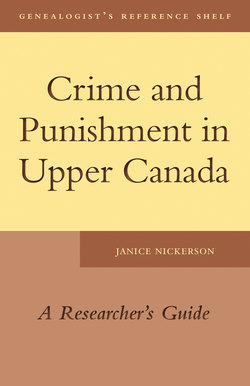Читать книгу Crime and Punishment in Upper Canada - Janice Nickerson - Страница 6
На сайте Литреса книга снята с продажи.
ОглавлениеPREFACE
The idea for this book was conceived as I struggled to understand the morass of records created by the Upper Canadian justice system in my work as a professional genealogist.
I was faced with a project in which a client’s ancestor had been accused of criminal activity. How could I find out more? Where should I look? The answers were not easy to find. And as I began examining the original records, I found them difficult to understand because I didn’t know enough about the way the justice system worked. I didn’t know who the personnel were, why they created the records they did, and how to locate those records that survived. I gradually came to believe that a guide for other researchers was needed.
Foremost in my mind were genealogists seeking to learn about their own ancestors’ brushes with the law. However, researchers in other historical fields may also find it useful to have information about the entire system of justice in Upper Canada and its records gathered in one place.
This is not a typical genealogist’s guide, in that it is only partly about the records. I have found that in order to locate and understand the records it is necessary to understand their context. So, the large part of this book is about the history of the criminal justice system in Upper Canada. I walk the reader through the criminal justice process, step-by-step, explaining who did what, and what records were created in the process. As I discuss the process I illustrate it with examples of original records. I’ve also provided an inventory of available records to assist the reader in determining which records are available for which location and time period. Each section also contains mini-case studies featuring the stories of real people whose lives were somehow touched by the justice system — as victims, criminals, witnesses, investigators, adjudicators, and administrators.
I have chosen to restrict my focus to the Upper Canada period, that is the years from 1791 to 1841. There are several reasons for this: First, this period is the formative one for the region that eventually became the province of Ontario. Understanding how the system began is critical to understanding later developments. While I considered expanding the period to cover the entire nineteenth century, I found that there were so many changes during the post-1841 period that it would be difficult to explain them all without confusing the reader. Second, with the growth in population came necessary expansions in the justice system, along with an exponential increase in the number and kinds of available records. It would be difficult to describe them all within the confines of a handy guide.
I have also limited myself to the criminal justice system. I have not included information about civil, probate, and equity courts, nor have I gone into any detail about the administrative functions of the courts that also handled criminal justice. However, I have defined criminal loosely.That is, I have included the treatment of misdemeanors and by-law infractions. Also, in my discussion of imprisonment, I have included information about other uses of the gaols (jails), such as the incarceration of debtors and the mentally ill.
